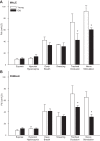Functional impact of diaphragm muscle sarcopenia in both male and female mice
- PMID: 25934669
- PMCID: PMC4491513
- DOI: 10.1152/ajplung.00064.2015
Functional impact of diaphragm muscle sarcopenia in both male and female mice
Abstract
To perform a range of ventilatory and nonventilatory behaviors, the diaphragm muscle (DIAm) must be able to generate sufficient forces throughout the lifespan. We hypothesized that sarcopenia impacts DIAm force generation and thus limits performance of expulsive, higher force, nonventilatory behaviors. Male and female mice (n = 79) at 6 and 24 mo of age (100 vs. 70-75% survival, respectively) were used to examine transdiaphragmatic pressure (Pdi) generation across motor behaviors in vivo and in vitro DIAm specific force. We found a significant effect of age on maximum Pdi (20-41% decline during tracheal occlusion and bilateral phrenic nerve stimulation), maximum DIAm specific force (30% decline), and DIAm fatigue resistance (15% increase). There were no differences between sexes in these age effects on DIAm performance. These results support our hypothesis that sarcopenia primarily impacts higher force, nonventilatory motor behaviors of the DIAm. Such functional limitations may have negative implications in the ability of the DIAm to generate forces needed for airway clearance in old age and thereby contribute to age-related respiratory complications.
Keywords: aging; respiratory muscles; sex differences; transdiaphragmatic pressure.
Copyright © 2015 the American Physiological Society.
Figures




Similar articles
-
Diaphragm muscle sarcopenia into very old age in mice.Physiol Rep. 2020 Jan;8(1):e14305. doi: 10.14814/phy2.14305. Physiol Rep. 2020. PMID: 31908152 Free PMC article.
-
Impact of aging on diaphragm muscle function in male and female Fischer 344 rats.Physiol Rep. 2018 Jul;6(13):e13786. doi: 10.14814/phy2.13786. Physiol Rep. 2018. PMID: 29981218 Free PMC article.
-
Impact of sarcopenia on diaphragm muscle fatigue.Exp Physiol. 2019 Jul;104(7):1090-1099. doi: 10.1113/EP087558. Epub 2019 Apr 22. Exp Physiol. 2019. PMID: 30924589 Free PMC article.
-
Functional impact of sarcopenia in respiratory muscles.Respir Physiol Neurobiol. 2016 Jun;226:137-46. doi: 10.1016/j.resp.2015.10.001. Epub 2015 Oct 20. Respir Physiol Neurobiol. 2016. PMID: 26467183 Free PMC article. Review.
-
Diaphragm plasticity in aging and disease: therapies for muscle weakness go from strength to strength.J Appl Physiol (1985). 2018 Aug 1;125(2):243-253. doi: 10.1152/japplphysiol.01059.2017. Epub 2018 Apr 19. J Appl Physiol (1985). 2018. PMID: 29672230 Free PMC article. Review.
Cited by
-
Mitochondrial respiration and H2O2 emission in saponin-permeabilized murine diaphragm fibers: optimization of fiber separation and comparison to limb muscle.Am J Physiol Cell Physiol. 2019 Oct 1;317(4):C665-C673. doi: 10.1152/ajpcell.00184.2019. Epub 2019 Jul 17. Am J Physiol Cell Physiol. 2019. PMID: 31314583 Free PMC article.
-
Phrenic motor neuron loss in aged rats.J Neurophysiol. 2018 May 1;119(5):1852-1862. doi: 10.1152/jn.00868.2017. Epub 2018 Feb 7. J Neurophysiol. 2018. PMID: 29412773 Free PMC article.
-
Janus kinase inhibition prevents cancer- and myocardial infarction-mediated diaphragm muscle weakness in mice.Am J Physiol Regul Integr Comp Physiol. 2016 Apr 15;310(8):R707-10. doi: 10.1152/ajpregu.00550.2015. Epub 2016 Feb 10. Am J Physiol Regul Integr Comp Physiol. 2016. PMID: 26864813 Free PMC article.
-
Chloroquine Causes Aging-like Changes in Diaphragm Neuromuscular Junction Morphology in Mice.Cells. 2025 Mar 7;14(6):390. doi: 10.3390/cells14060390. Cells. 2025. PMID: 40136639 Free PMC article.
-
Relationship Between Diaphragm Function and Sarcopenia Assessed by Ultrasound: A Cross-Sectional Study.Diagnostics (Basel). 2025 Jan 3;15(1):90. doi: 10.3390/diagnostics15010090. Diagnostics (Basel). 2025. PMID: 39795617 Free PMC article.
References
Publication types
MeSH terms
Grants and funding
LinkOut - more resources
Full Text Sources
Other Literature Sources
Medical

